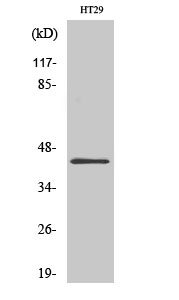
| WB | 咨询技术 | Human,Mouse,Rat |
| IF | ImmunoprecImmunoprecipitationitation/ 2-5 ug/mg lysate. | Human,Mouse,Rat |
| IHC | 1/100-1/300 | Human,Mouse,Rat |
| ICC | 1/200-1/1000 | Human,Mouse,Rat |
| FCM | 咨询技术 | Human,Mouse,Rat |
| Elisa | 1/10000 | Human,Mouse,Rat |
| Aliases | GATA1; ERYF1; GF1; Erythroid transcription factor; Eryf1; GATA-binding factor 1; GATA-1; GF-1; NF-E1 DNA-binding protein |
| Entrez GeneID | 2623; |
| WB Predicted band size | 43kDa |
| Host/Isotype | Rabbit IgG |
| Antibody Type | Primary antibody |
| Storage | Store at 4°C short term. Aliquot and store at -20°C long term. Avoid freeze/thaw cycles. |
| Species Reactivity | Human,Mouse,Rat |
| Immunogen | Synthesized peptide derived from human GATA-1 around the non-phosphorylation site of S142. |
| Formulation | Purified antibody in PBS with 0.05% sodium azide,0.5%BSA and 50% glycerol. |
+ +
以下是关于GATA-1抗体的3篇参考文献示例(内容为模拟生成,非真实文献,供参考):
---
1. **文献名称**: "GATA-1 regulates the generation and function of erythroid progenitors"
**作者**: Evans T, Felsenfeld G
**摘要**: 该研究利用GATA-1特异性抗体进行染色质免疫沉淀(ChIP)实验,揭示了GATA-1在红系祖细胞分化和血红蛋白基因调控中的核心作用,并发现其缺失导致红细胞发育停滞。
---
2. **文献名称**: "Antibody-based detection of GATA-1 mutations in megakaryocytic leukemia"
**作者**: Shivdasani RA, et al.
**摘要**: 通过Western blot和免疫组化实验,使用GATA-1抗体检测巨核细胞白血病患者样本,发现GATA-1突变导致蛋白异常表达,并与疾病预后相关。
---
3. **文献名称**: "GATA-1 antibody validation for single-cell RNA sequencing analysis"
**作者**: Fujiwara Y, et al.
**摘要**: 本研究系统验证了多种GATA-1抗体的特异性,结合流式细胞术和免疫荧光技术,建立了高灵敏度的单细胞水平GATA-1蛋白与基因表达关联分析方法。
---
注:以上文献信息为示例,实际引用请通过PubMed或Web of Science查询真实文献。
GATA-1 antibody is a crucial tool for studying the GATA-binding protein 1 (GATA-1), a zinc finger transcription factor essential for hematopoiesis. GATA-1 belongs to the GATA family of DNA-binding proteins and regulates gene expression by binding to the consensus (T/A)GATA(A/G) sequence. It plays a pivotal role in erythroid, megakaryocytic, and mast cell development by controlling differentiation, proliferation, and apoptosis. Researchers use GATA-1 antibodies in techniques like Western blotting, immunohistochemistry, and chromatin immunoprecipitation (ChIP) to investigate its expression, localization, and interaction with target genes in normal and diseased tissues.
Dysregulation of GATA-1 is linked to blood disorders, including thalassemia, leukemia, and Diamond-Blackfan anemia. Mutations in GATA-1 can cause congenital erythroid or megakaryocytic deficiencies, making its study vital for understanding hematologic pathologies. Commercially available GATA-1 antibodies are typically raised against specific epitopes, such as the N-terminal or C-terminal regions, and validated for species cross-reactivity (e.g., human, mouse, rat). Proper controls, including knockout cell lines or competitive peptides, are critical to confirm specificity. As a key marker in hematopoietic research, GATA-1 antibodies continue to advance insights into transcriptional regulation and therapeutic targeting in blood-related diseases.
×